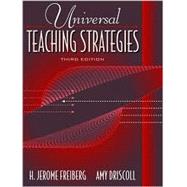
Universal Teaching Strategies
by Freiberg, H. Jerome; Driscoll, AmyRent Textbook
New Textbook
We're Sorry
Sold Out
Used Textbook
We're Sorry
Sold Out
eTextbook
We're Sorry
Not Available
How Marketplace Works:
- This item is offered by an independent seller and not shipped from our warehouse
- Item details like edition and cover design may differ from our description; see seller's comments before ordering.
- Sellers much confirm and ship within two business days; otherwise, the order will be cancelled and refunded.
- Marketplace purchases cannot be returned to eCampus.com. Contact the seller directly for inquiries; if no response within two days, contact customer service.
- Additional shipping costs apply to Marketplace purchases. Review shipping costs at checkout.
Summary
Table of Contents
Most chapters begin with “Introduction” and end with “Summary,” “Reference(s),” and “Samples and Examples.”
PREFACE.
I. ORGANIZING STRATEGIES.
1. Teaching for Tomorrow: Context, Content, and Learners.
Universal Teaching Strategies.
The Context of Teaching for Tomorrow.
The Content of Teaching for Tomorrow.
The Learners of Today and Tomorrow.
Facing Tomorrow.
2. Planning for Instruction:
Visualizing What Could Be.
Three Voices of Planning.
Functions of Planning.
Planning Phases.
Considerations for Planning.
Sources of Information for Planning.
Students with Special Needs.
3. Designing Effective Instruction: Creating a Blueprint.
Models of Instructional Design.
Designs for Varied Time Periods.
Lesson Beginnings and Endings.
Instructional Objectives.
Instructional Design and Inclusion.
Efficiency in Design.
Collaborative Planning and Designs.
4. The Effective Use of Time:
Doing More with Less.
Thinking about Time for Teaching and Learning.
Time and the Inclusive Classroom.
Time Savers.
5. Classroom Management: Advancework.
Context Advancework.
Content Advancework.
Learner Advancework.
6. Classroom Management:
Beyond Discipline.
Classroom Management Strategies.
Models of Classroom Management.
Smoothness and Momentum.
Students with Special Needs.
II. INSTRUCTING STRATEGIES.
7. Lecture: From Passive to Active Learning.
Style without Substance.
Learner, Context, and Content.
Teacher Control.
Teaching Note Taking.
8. Questioning and Discussion: Creating a Dialogue.
Types of Questions.
Cautions and Concerns.
Classroom Discussion.
Other Key Points.
9. Interactive Practice for Learning: Beyond Drill.
Content.
Context.
Learner.
Interactive Practice Strategies.
10. Grouping for Instruction: Involvement and Interaction.
Implications for Grouping.
Grouping for Teaching and Learning.
11. Reflective Teaching and Learning: Students as Shareholders.
Context.
Learner.
Content.
Reflective Teaching Strategies.
12. Making Learning Real: Engaging Students in Content.
Context.
Content.
Learner.
Teaching with Improvisation and Service Learning.
Teaching Roles for Improvisation and Service Learning.
13. Using Community Resources, Audiovisuals, Computers, and Multimedia: Varying the Stimuli.
Using Community Resources, Audiovisuals, Computers, and Multimedia.
Audiovisual Stimuli.
Computers and Multimedia.
III. ASSESSING STRATEGIES.
14. Assessment of Learning: Let Me Count the Ways.
Purposes of Assessment.
How to Assess Learning — Let Me Count the Ways.
Assessment and Inclusion.
Final Considerations for Assessment.
15. Self-Improvement through Self-Assessment.
Self-Assessment: Creating Change from Within.
Two Teachers Analyze Their Classrooms.
Student Feedback.
Student Feedback Instruments.
Data from Peer Observations.
Author Index.
Subject Index.
An electronic version of this book is available through VitalSource.
This book is viewable on PC, Mac, iPhone, iPad, iPod Touch, and most smartphones.
By purchasing, you will be able to view this book online, as well as download it, for the chosen number of days.
Digital License
You are licensing a digital product for a set duration. Durations are set forth in the product description, with "Lifetime" typically meaning five (5) years of online access and permanent download to a supported device. All licenses are non-transferable.
More details can be found here.
A downloadable version of this book is available through the eCampus Reader or compatible Adobe readers.
Applications are available on iOS, Android, PC, Mac, and Windows Mobile platforms.
Please view the compatibility matrix prior to purchase.
